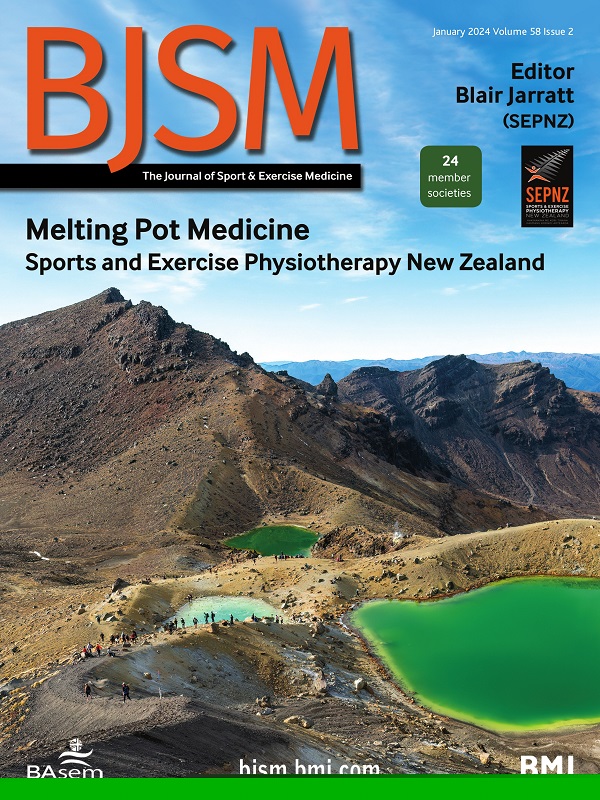Effectiveness of cryotherapy on pain intensity, range of motion, swelling and function in the postoperative care of musculoskeletal disorders: a systematic review and meta-analysis of randomised controlled trials
IF 16.2
1区 医学
Q1 SPORT SCIENCES
引用次数: 0
Abstract
Objective To investigate the effectiveness of cryotherapy on pain intensity, range of motion (ROM), swelling and function in the postoperative care of musculoskeletal disorders. Design Systematic review and meta-analysis, with estimates presented as mean differences (MDs) or standardised MDs (SMDs) with 95% CIs. Effect sizes were interpreted according to the minimum clinically important difference (MCID) of 2 points for pain and 11 points for function, or Cohen’s thresholds. Data sources Searches were conducted in MEDLINE, COCHRANE, EMBASE and PEDro databases. Eligibility criteria Randomised controlled trials (RCTs) involving individuals undergoing postoperative rehabilitation for musculoskeletal disorders, comparing cryotherapy vs no cryotherapy, on pain intensity, ROM, swelling and function. Results 28 RCTs were included. The Grading of Recommendations Assessment, Development and Evaluation assessment demonstrated a very low to moderate certainty of evidence. For pain intensity, a statistically significant difference favouring cryotherapy was observed in the immediate (MD −0.77, 95% CI –1.23 to −0.31), short (MD −0.84, 95% CI –1.17 to −0.51) and medium term (MD −0.41, 95% CI –0.65 to −0.17). However, these effect sizes were below the MCID. For ROM, we found small to medium effect sizes in the immediate (SMD 0.37, 95% CI 0.09 to 0.66), short (SMD 0.51, 95% CI 0.25 to 0.77) and medium term (SMD 0.61, 95% CI 0.04 to 1.18). Small short-term effects were found for swelling (SMD −0.35, 95% CI –0.64 to −0.05) and function (MD 3.45, 95% CI 0.69 to 6.20; not clinically relevant). Conclusions Cryotherapy produced minor benefits on pain intensity and ROM, but the effect sizes may not be clinically relevant. Evidence for swelling and function was of low certainty and showed no substantial benefit. All data relevant to the study are included in the article or uploaded as supplementary information. Not applicable. All relevant data extracted for this systematic review are included within the manuscript and its supplementary information files.在肌肉骨骼疾病的术后护理中,冷冻疗法对疼痛强度、活动范围、肿胀和功能的有效性:随机对照试验的系统回顾和荟萃分析
目的探讨冷冻治疗在肌肉骨骼疾病术后护理中对疼痛强度、活动度、肿胀及功能的影响。设计系统评价和荟萃分析,以95% ci的平均差异(MDs)或标准化MDs (SMDs)表示估计值。效应量根据最小临床重要差异(MCID)(疼痛2分,功能11分)或科恩阈值进行解释。在MEDLINE、COCHRANE、EMBASE和PEDro数据库中进行检索。随机对照试验(rct)涉及接受肌肉骨骼疾病术后康复的个体,比较冷冻治疗与未冷冻治疗,疼痛强度,ROM,肿胀和功能。结果共纳入28项随机对照试验。建议分级评估、发展和评价评估显示证据的确定性非常低到中等。对于疼痛强度,在近期(MD - 0.77, 95% CI -1.23至- 0.31)、短期(MD - 0.84, 95% CI -1.17至- 0.51)和中期(MD - 0.41, 95% CI -0.65至- 0.17)中,支持冷冻疗法的差异具有统计学意义。然而,这些效应量低于MCID。对于ROM,我们发现在短期(SMD 0.37, 95% CI 0.09至0.66),短期(SMD 0.51, 95% CI 0.25至0.77)和中期(SMD 0.61, 95% CI 0.04至1.18)中存在中小型效应大小。在肿胀(SMD = - 0.35, 95% CI = -0.64 ~ - 0.05)和功能(MD = 3.45, 95% CI = 0.69 ~ 6.20,无临床相关性)方面发现了较小的短期影响。结论冷冻疗法对疼痛强度和ROM的影响较小,但效果大小可能与临床无关。肿胀和功能的证据是低确定性的,没有显示出实质性的好处。所有与研究相关的数据都包含在文章中或作为补充信息上传。不适用。本次系统综述中提取的所有相关数据都包含在稿件及其补充信息文件中。
本文章由计算机程序翻译,如有差异,请以英文原文为准。
求助全文
约1分钟内获得全文
求助全文
来源期刊
CiteScore
27.10
自引率
4.90%
发文量
217
审稿时长
3-8 weeks
期刊介绍:
The British Journal of Sports Medicine (BJSM) is a dynamic platform that presents groundbreaking research, thought-provoking reviews, and meaningful discussions on sport and exercise medicine. Our focus encompasses various clinically-relevant aspects such as physiotherapy, physical therapy, and rehabilitation. With an aim to foster innovation, education, and knowledge translation, we strive to bridge the gap between research and practical implementation in the field. Our multi-media approach, including web, print, video, and audio resources, along with our active presence on social media, connects a global community of healthcare professionals dedicated to treating active individuals.

 求助内容:
求助内容: 应助结果提醒方式:
应助结果提醒方式:


